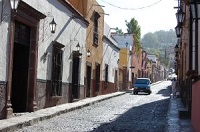Expats in Mexico are often worried about driving, as they have heard stories about drug cartels, crooked cops, and carjackings. While there is some basis for these stories, most of the information is greatly exaggerated. It is true that many of these problems exist, but most of it is concentrated on the back roads and not on the main highways. Driving in Mexico can be a great experience, so here are a few driving tips to help you get around.
The Green Angels
The Angeles Verdes or The Green Angels is a government-run organization of auto mechanics that provide free assistance in case of a breakdown or accident. The organization has an impressive 300 vehicles that patrol the Mexican highways on a daily basis.The crew is trained in mechanics as well as first aid, and most of them are bilingual. While the service is completely free, you may need to pay for parts, gas, oil or other required items. It is considered to be common courtesy to tip the crew or buy them lunch. The emergency number for The Green Angels is 078.
Driving Bans in Mexican Cities
Unfiltered car exhaust coupled with severe congestion has resulted in a high level of pollution in the cities. In order to tackle this problem, the Mexican government started the Hoy no circula (“don’t drive today”) project. According to this system, cars with a specific last number in their license plate are not allowed to drive in the city from 5 am to 10 pm on certain days of the week. For instance, you would not be able to drive around the city on a Tuesday if your license plate ended in 5 and the ban on Tuesday is for the number 5. Motorcycles, vehicles with a visitor pass and low emission cars that have received a verification of “0” or “00” are not included in this ban.
Potholes and livestock on the highway
It can be a challenge to drive on the regular highways, as these roads are often dotted with deep potholes and rock debris. Furthermore, you may swing around a corner only to find the road blocked by livestock. If you must use these roads, travel at a slower speed than you normally would, as driving through a bad pothole can burst your tire or even cause your axle to break.
Topes (Speed Bumps)
These speed bumps are unlike any others that most expats have seen, as they are about three times as large as regular speed bumps. In order to cross the tope gently and safely, you need to slow down drastically. Unsuspecting expats often slow down just slightly, as they normally would in their home country, and then realize the danger too late. Sometimes there are signposts to warn about upcoming speed bumps, but this is not always the case, so one must always keep an eye out for them. Consider underbody protection or at least protection for the oil pan and gearbox.
Speed Limit
The speed limits in Mexico depend on the neighboring areas. This means that the speed limit is much lower in the cities (just 25 miles per hour) and they are considerably higher (50 miles per hour) outside the cities. The speed limit on the highways is 70 miles per hour. As an expat, you would not be familiar with the Mexican style of driving, which can be a little erratic and dangerous. When diving in Mexico, err on the side of caution, and make sure that you are well below the maximum speed limit. Even if other cars seem to ignore the rules of the road, you should follow them diligently.
Carjacking
When driving through Mexico’s remote outback, stay alert, as there have been cases of car thefts, robberies and kidnappings. Do not pick up hitchhikers or strangers, as criminals often use this ruse on unsuspecting non-Mexicans in order to carjack them. Similarly, they might pretend to have car trouble, and as you approach the “broken-down” vehicle, they spring the trap.
Toll roads
Toll roads (autopistas de cuota) might cost a bit more, but they are in relatively good condition, and since they are less travelled, there is less traffic congestion on them too. A few of the bigger toll booths accept credit cards, but most of them only accept payment in pesos. You can visit ‘Traza Tu Ruta‘ to plan your route as well as find information of the toll costs you will incur.

